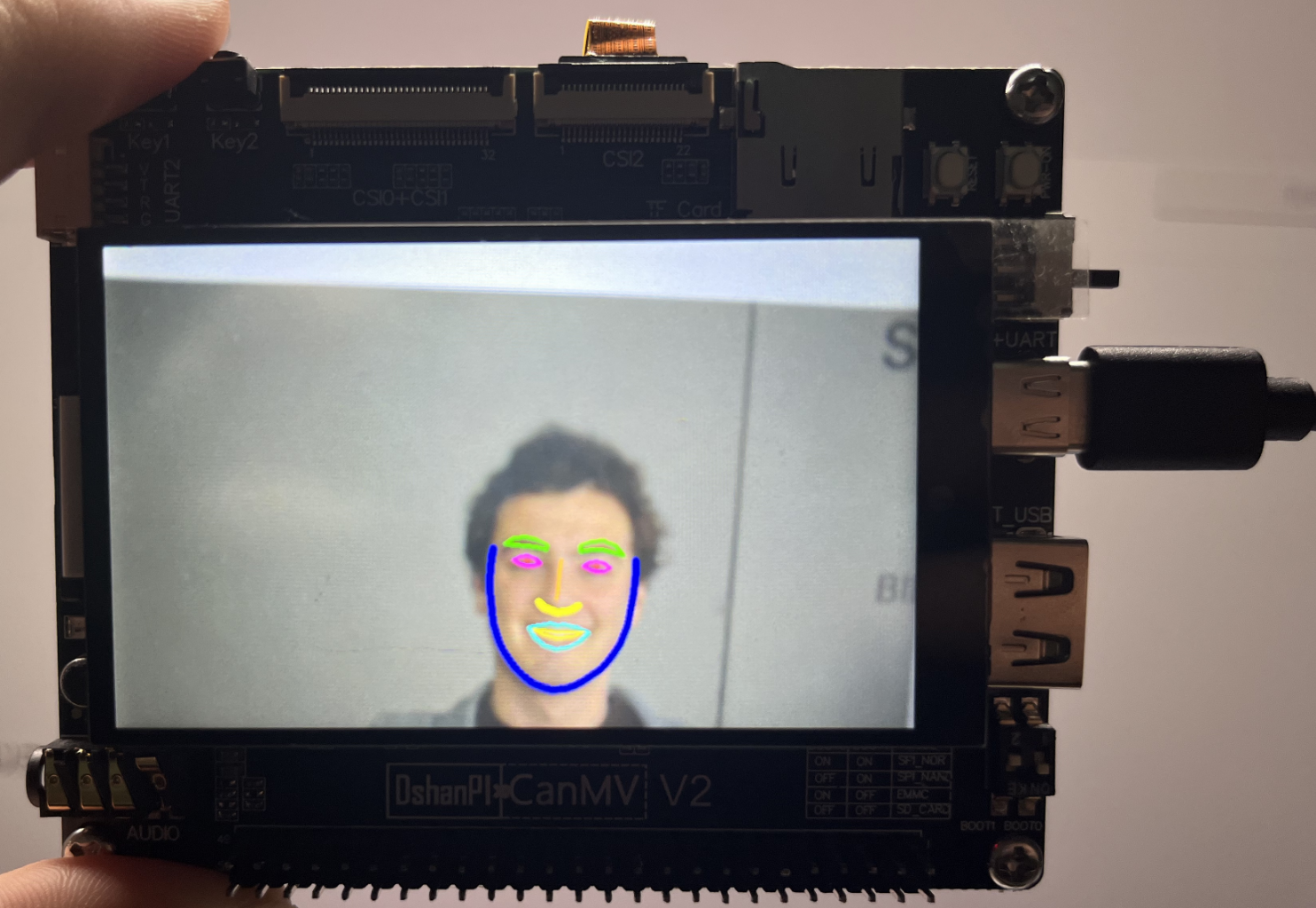人脸关键部位
1.实验目的
学�习摄像头获取的图像中人脸关键部位的获取。
2.核心代码
本代码实现了一个双模型协同工作的人脸关键点检测系统,包含人脸检测(FaceDetApp)和关键点定位(FaceLandMarkApp)两个阶段,通过FaceLandMark类整合流程。系统架构图如下:
图像输入 → Pipeline获取帧 → 人脸检测 → 关键点检测 → 结果绘制 → HDMI/LCD显示
1. FaceDetApp(人脸检测)
-
预处理:
- 等比例填充:通过
get_pad_param()计算填充参数,保持宽高比(避免变形) - 缩放至320x320:使用双线性插值缩放至模型输入尺寸
# 计算填充参数示例
ratio = min(320/原图宽, 320/原图高)
new_w = 原图宽*ratio → 填充左右使总宽=320 - 等比例填充:通过
-
后处理:
- 调用
aidemo.face_det_post_process进行置信度过滤和NMS - 返回格式:
[x1,y1,w,h,conf]的检测框列表
- 调用
2. FaceLandMarkApp(关键点检测)
-
仿射变换预处理:
- 根据人脸框计算仿射矩阵,将人脸区域对齐到192x192输入
matrix_dst = [
[scale, 0, 平移X],
[0, scale, 平移Y]
]- 通过
affine()实现旋转+缩放+平移的复合变换
-
关键点后处理:
- 坐标反变换:使用逆矩阵将关键点映射回原图坐标
new_x = old_x * inv[0] + old_y * inv[1] + inv[2]
new_y = old_x * inv[3] + old_y * inv[4] + inv[5]
3. FaceLandMark(整合类)
- 多部位关键点绘制:
- 划分10个面部区域(眉毛/眼睛/嘴唇等)
- 使用不同绘图方式:
- 轮廓线:
aidemo.contours()画眉毛/嘴唇 - 折线:
aidemo.polylines()画鼻梁 - 圆点:
draw_circle()画瞳孔
- 轮廓线:
仿射矩阵计算
def get_affine_matrix(bbox):
scale = 192 / (max(w,h)*1.5) # 保留1.5倍边缘上下文
cx = (x1 + w/2) * scale # 原图中心点映射
cy = (y1 + h/2) * scale
matrix_dst[0,2] = 96 - cx # 平移到模型中心(96=192/2)
关键点逆变换
# 逆变换流程
1. 关键点输出值域[-1,1] → 转换到[0,192]
pred[i] = (pred[i]+1)*96
2. 通过逆矩阵映射回原图坐标
多线程优化
- ScopedTiming:��代码中多处使用性能计时器,便于优化瓶颈
- 内存管理:显式调用
gc.collect()应对嵌入式内存限制
假设检测到一个人脸框(x=100,y=200,w=300,h=300):
-
关键点预处理:
-
计算scale=192/(300*1.5)=0.426
-
生成仿射矩阵:
[[0.426, 0, 96-127.5],
[0, 0.426, 96-212.5]]
-
-
关键点输出:
- 模型输出归一化坐标 → 反归一化到192x192空间
- 通过逆矩阵映射回1080P原图坐标
3.示例代码
'''
本程序遵循GPL V3协议, 请遵循协议
实验平台: DshanPI CanMV
开发板文档站点 : https://eai.100ask.net/
百问网学习平台 : https://www.100ask.net
百问网官方B站 : https://space.bilibili.com/275908810
百问网官方淘宝 : https://100ask.taobao.com
'''
from libs.PipeLine import PipeLine, ScopedTiming
from libs.AIBase import AIBase
from libs.AI2D import Ai2d
import os
import ujson
from media.media import *
from time import *
import nncase_runtime as nn
import ulab.numpy as np
import time
import image
import aidemo
import random
import gc
import sys
# 自定义人脸检测任务类
class FaceDetApp(AIBase):
def __init__(self,kmodel_path,model_input_size,anchors,confidence_threshold=0.25,nms_threshold=0.3,rgb888p_size=[1280,720],display_size=[1920,1080],debug_mode=0):
super().__init__(kmodel_path,model_input_size,rgb888p_size,debug_mode)
# kmodel路径
self.kmodel_path=kmodel_path
# 检测模型输入分辨率
self.model_input_size=model_input_size
# 置信度阈值
self.confidence_threshold=confidence_threshold
# nms阈值
self.nms_threshold=nms_threshold
# 检测任务锚框
self.anchors=anchors
# sensor给到AI的图像分辨率,宽16字节对齐
self.rgb888p_size=[ALIGN_UP(rgb888p_size[0],16),rgb888p_size[1]]
# 视频输出VO分辨率,宽16字节对齐
self.display_size=[ALIGN_UP(display_size[0],16),display_size[1]]
# debug模式
self.debug_mode=debug_mode
# 实例化Ai2d,用于实现模型预处理
self.ai2d=Ai2d(debug_mode)
# 设置Ai2d的输入输出格式和类型
self.ai2d.set_ai2d_dtype(nn.ai2d_format.NCHW_FMT,nn.ai2d_format.NCHW_FMT,np.uint8, np.uint8)
# 配置预处理操作,这里使用了pad和resize,Ai2d支持crop/shift/pad/resize/affine,具体代码请打开/sdcard/app/libs/AI2D.py查看
def config_preprocess(self,input_image_size=None):
with ScopedTiming("set preprocess config",self.debug_mode > 0):
# 初始化ai2d预处理配置,默认为sensor给到AI的尺寸,可以通过设置input_image_size自行修改输入尺寸
ai2d_input_size=input_image_size if input_image_size else self.rgb888p_size
# 设置padding预处理
self.ai2d.pad(self.get_pad_param(), 0, [104,117,123])
# 设置resize预处理
self.ai2d.resize(nn.interp_method.tf_bilinear, nn.interp_mode.half_pixel)
# 构建预处理流程,参数为预处理输入tensor的shape和预处理输出的tensor的shape
self.ai2d.build([1,3,ai2d_input_size[1],ai2d_input_size[0]],[1,3,self.model_input_size[1],self.model_input_size[0]])
# 自定义后处理,results是模型输出的array列表,这里使用了aidemo的face_det_post_process列表
def postprocess(self,results):
with ScopedTiming("postprocess",self.debug_mode > 0):
res = aidemo.face_det_post_process(self.confidence_threshold,self.nms_threshold,self.model_input_size[0],self.anchors,self.rgb888p_size,results)
if len(res)==0:
return res
else:
return res[0]
# 计算padding参数
def get_pad_param(self):
dst_w = self.model_input_size[0]
dst_h = self.model_input_size[1]
# 计算最小的缩放比例,等比例缩放
ratio_w = dst_w / self.rgb888p_size[0]
ratio_h = dst_h / self.rgb888p_size[1]
if ratio_w < ratio_h:
ratio = ratio_w
else:
ratio = ratio_h
new_w = (int)(ratio * self.rgb888p_size[0])
new_h = (int)(ratio * self.rgb888p_size[1])
dw = (dst_w - new_w) / 2
dh = (dst_h - new_h) / 2
top = (int)(round(0))
bottom = (int)(round(dh * 2 + 0.1))
left = (int)(round(0))
right = (int)(round(dw * 2 - 0.1))
return [0,0,0,0,top, bottom, left, right]
# 自定义人脸关键点任务类
class FaceLandMarkApp(AIBase):
def __init__(self,kmodel_path,model_input_size,rgb888p_size=[1920,1080],display_size=[1920,1080],debug_mode=0):
super().__init__(kmodel_path,model_input_size,rgb888p_size,debug_mode)
# kmodel路径
self.kmodel_path=kmodel_path
# 关键点模型输入分辨率
self.model_input_size=model_input_size
# sensor给到AI的图像分辨率,宽16字节对齐
self.rgb888p_size=[ALIGN_UP(rgb888p_size[0],16),rgb888p_size[1]]
# 视频输出VO分辨率,宽16字节对齐
self.display_size=[ALIGN_UP(display_size[0],16),display_size[1]]
# debug模式
self.debug_mode=debug_mode
# 目标矩阵
self.matrix_dst=None
self.ai2d=Ai2d(debug_mode)
self.ai2d.set_ai2d_dtype(nn.ai2d_format.NCHW_FMT,nn.ai2d_format.NCHW_FMT,np.uint8, np.uint8)
# 配置预处理操作,这里使用了affine,Ai2d支持crop/shift/pad/resize/affine,具体代码请打开/sdcard/app/libs/AI2D.py查看
def config_preprocess(self,det,input_image_size=None):
with ScopedTiming("set preprocess config",self.debug_mode > 0):
# 初始化ai2d预处理配置,默认为sensor给到AI的尺寸,可以通过设置input_image_size自行修改输入尺寸
ai2d_input_size=input_image_size if input_image_size else self.rgb888p_size
# 计算目标矩阵,并获取仿射变换矩阵
self.matrix_dst = self.get_affine_matrix(det)
affine_matrix = [self.matrix_dst[0][0],self.matrix_dst[0][1],self.matrix_dst[0][2],
self.matrix_dst[1][0],self.matrix_dst[1][1],self.matrix_dst[1][2]]
# 设置仿射变换预处理
self.ai2d.affine(nn.interp_method.cv2_bilinear,0, 0, 127, 1,affine_matrix)
# 构建预处理流程,参数为预处理输入tensor的shape和预处理输出的tensor的shape
self.ai2d.build([1,3,ai2d_input_size[1],ai2d_input_size[0]],[1,3,self.model_input_size[1],self.model_input_size[0]])
# 自定义后处理,results是模型输出的array列表,这里使用了aidemo库的invert_affine_transform接口
def postprocess(self,results):
with ScopedTiming("postprocess",self.debug_mode > 0):
pred=results[0]
# (1)将人脸关键点输出变换模型输入
half_input_len = self.model_input_size[0] // 2
pred = pred.flatten()
for i in range(len(pred)):
pred[i] += (pred[i] + 1) * half_input_len
# (2)获取仿射矩阵的逆矩阵
matrix_dst_inv = aidemo.invert_affine_transform(self.matrix_dst)
matrix_dst_inv = matrix_dst_inv.flatten()
# (3)对每个关键点进行逆变换
half_out_len = len(pred) // 2
for kp_id in range(half_out_len):
old_x = pred[kp_id * 2]
old_y = pred[kp_id * 2 + 1]
# 逆变换公式
new_x = old_x * matrix_dst_inv[0] + old_y * matrix_dst_inv[1] + matrix_dst_inv[2]
new_y = old_x * matrix_dst_inv[3] + old_y * matrix_dst_inv[4] + matrix_dst_inv[5]
pred[kp_id * 2] = new_x
pred[kp_id * 2 + 1] = new_y
return pred
def get_affine_matrix(self,bbox):
# 获取仿射矩阵,用于将边界框映射到模型输入空间
with ScopedTiming("get_affine_matrix", self.debug_mode > 1):
# 从边界框提取坐标和尺寸
x1, y1, w, h = map(lambda x: int(round(x, 0)), bbox[:4])
# 计算缩放比例,使得边界框映射到模型输入空间的一部分
scale_ratio = (self.model_input_size[0]) / (max(w, h) * 1.5)
# 计算边界框中心点在模型输入空间的坐标
cx = (x1 + w / 2) * scale_ratio
cy = (y1 + h / 2) * scale_ratio
# 计算模型输入空间的一半长度
half_input_len = self.model_input_size[0] / 2
# 创建仿射矩阵并进行设置
matrix_dst = np.zeros((2, 3), dtype=np.float)
matrix_dst[0, 0] = scale_ratio
matrix_dst[0, 1] = 0
matrix_dst[0, 2] = half_input_len - cx
matrix_dst[1, 0] = 0
matrix_dst[1, 1] = scale_ratio
matrix_dst[1, 2] = half_input_len - cy
return matrix_dst
# 人脸标志解析
class FaceLandMark:
def __init__(self,face_det_kmodel,face_landmark_kmodel,det_input_size,landmark_input_size,anchors,confidence_threshold=0.25,nms_threshold=0.3,rgb888p_size=[1920,1080],display_size=[1920,1080],debug_mode=0):
# 人脸检测模型路径
self.face_det_kmodel=face_det_kmodel
# 人脸标志解析模型路径
self.face_landmark_kmodel=face_landmark_kmodel
# 人脸检测模型输入分辨率
self.det_input_size=det_input_size
# 人脸标志解析模型输入分辨率
self.landmark_input_size=landmark_input_size
# anchors
self.anchors=anchors
# 置信度阈值
self.confidence_threshold=confidence_threshold
# nms阈值
self.nms_threshold=nms_threshold
# sensor给到AI的图像分辨率,宽16字节对齐
self.rgb888p_size=[ALIGN_UP(rgb888p_size[0],16),rgb888p_size[1]]
# 视频输出VO分辨率,宽16字节对齐
self.display_size=[ALIGN_UP(display_size[0],16),display_size[1]]
# debug_mode模式
self.debug_mode=debug_mode
# 人脸关键点不同部位关键点列表
self.dict_kp_seq = [
[43, 44, 45, 47, 46, 50, 51, 49, 48], # left_eyebrow
[97, 98, 99, 100, 101, 105, 104, 103, 102], # right_eyebrow
[35, 36, 33, 37, 39, 42, 40, 41], # left_eye
[89, 90, 87, 91, 93, 96, 94, 95], # right_eye
[34, 88], # pupil
[72, 73, 74, 86], # bridge_nose
[77, 78, 79, 80, 85, 84, 83], # wing_nose
[52, 55, 56, 53, 59, 58, 61, 68, 67, 71, 63, 64], # out_lip
[65, 54, 60, 57, 69, 70, 62, 66], # in_lip
[1, 9, 10, 11, 12, 13, 14, 15, 16, 2, 3, 4, 5, 6, 7, 8, 0, 24, 23, 22, 21, 20, 19, 18, 32, 31, 30, 29, 28, 27, 26, 25, 17] # basin
]
# 人脸关键点不同部位(顺序同dict_kp_seq)颜色配置,argb
self.color_list_for_osd_kp = [
(255, 0, 255, 0),
(255, 0, 255, 0),
(255, 255, 0, 255),
(255, 255, 0, 255),
(255, 255, 0, 0),
(255, 255, 170, 0),
(255, 255, 255, 0),
(255, 0, 255, 255),
(255, 255, 220, 50),
(255, 30, 30, 255)
]
# 人脸检测实例
self.face_det=FaceDetApp(self.face_det_kmodel,model_input_size=self.det_input_size,anchors=self.anchors,confidence_threshold=self.confidence_threshold,nms_threshold=self.nms_threshold,rgb888p_size=self.rgb888p_size,display_size=self.display_size,debug_mode=0)
# 人脸标志解析实例
self.face_landmark=FaceLandMarkApp(self.face_landmark_kmodel,model_input_size=self.landmark_input_size,rgb888p_size=self.rgb888p_size,display_size=self.display_size)
# 配置人脸检测的预处理
self.face_det.config_preprocess()
# run函数
def run(self,input_np):
# 执行人脸检测
det_boxes=self.face_det.run(input_np)
landmark_res=[]
for det_box in det_boxes:
# 对每一个检测到的人脸解析关键部位
self.face_landmark.config_preprocess(det_box)
res=self.face_landmark.run(input_np)
landmark_res.append(res)
return det_boxes,landmark_res
# 绘制人脸解析效果
def draw_result(self,pl,dets,landmark_res):
pl.osd_img.clear()
if dets:
draw_img_np = np.zeros((self.display_size[1],self.display_size[0],4),dtype=np.uint8)
draw_img = image.Image(self.display_size[0], self.display_size[1], image.ARGB8888, alloc=image.ALLOC_REF,data = draw_img_np)
for pred in landmark_res:
# (1)获取单个人脸框对应的人脸关键点
for sub_part_index in range(len(self.dict_kp_seq)):
# (2)构建人脸某个区域关键点集
sub_part = self.dict_kp_seq[sub_part_index]
face_sub_part_point_set = []
for kp_index in range(len(sub_part)):
real_kp_index = sub_part[kp_index]
x, y = pred[real_kp_index * 2], pred[real_kp_index * 2 + 1]
x = int(x * self.display_size[0] // self.rgb888p_size[0])
y = int(y * self.display_size[1] // self.rgb888p_size[1])
face_sub_part_point_set.append((x, y))
# (3)画人脸不同区域的轮廓
if sub_part_index in (9, 6):
color = np.array(self.color_list_for_osd_kp[sub_part_index],dtype = np.uint8)
face_sub_part_point_set = np.array(face_sub_part_point_set)
aidemo.polylines(draw_img_np, face_sub_part_point_set,False,color,5,8,0)
elif sub_part_index == 4:
color = self.color_list_for_osd_kp[sub_part_index]
for kp in face_sub_part_point_set:
x,y = kp[0],kp[1]
draw_img.draw_circle(x,y ,2, color, 1)
else:
color = np.array(self.color_list_for_osd_kp[sub_part_index],dtype = np.uint8)
face_sub_part_point_set = np.array(face_sub_part_point_set)
aidemo.contours(draw_img_np, face_sub_part_point_set,-1,color,2,8)
pl.osd_img.copy_from(draw_img)
if __name__=="__main__":
# 显示模式,默认"hdmi",可以选择"hdmi"和"lcd"
display_mode="lcd"
# k230保持不变,k230d可调整为[640,360]
rgb888p_size = [1920, 1080]
if display_mode=="hdmi":
display_size=[1920,1080]
else:
display_size=[800,480]
# 人脸检测模型路径
face_det_kmodel_path="/sdcard/examples/kmodel/face_detection_320.kmodel"
# 人脸关键标志模型路径
face_landmark_kmodel_path="/sdcard/examples/kmodel/face_landmark.kmodel"
# 其它参数
anchors_path="/sdcard/examples/utils/prior_data_320.bin"
face_det_input_size=[320,320]
face_landmark_input_size=[192,192]
confidence_threshold=0.5
nms_threshold=0.2
anchor_len=4200
det_dim=4
anchors = np.fromfile(anchors_path, dtype=np.float)
anchors = anchors.reshape((anchor_len,det_dim))
# 初始化PipeLine,只关注传给AI的图像分辨率,显示的分辨率
pl=PipeLine(rgb888p_size=rgb888p_size,display_size=display_size,display_mode=display_mode)
pl.create()
flm=FaceLandMark(face_det_kmodel_path,face_landmark_kmodel_path,det_input_size=face_det_input_size,landmark_input_size=face_landmark_input_size,anchors=anchors,confidence_threshold=confidence_threshold,nms_threshold=nms_threshold,rgb888p_size=rgb888p_size,display_size=display_size)
try:
while True:
os.exitpoint()
with ScopedTiming("total",1):
img=pl.get_frame() # 获取当前帧
det_boxes,landmark_res=flm.run(img) # 推理当前帧
flm.draw_result(pl,det_boxes,landmark_res) # 绘制推理结果
pl.show_image() # 展示推理效果
gc.collect()
except Exception as e:
sys.print_exception(e)
finally:
flm.face_det.deinit()
flm.face_landmark.deinit()
pl.destroy()
4.实验结果

点击运行代码后,可以在显示屏上看到人脸关键部位的结果。如下所示:
